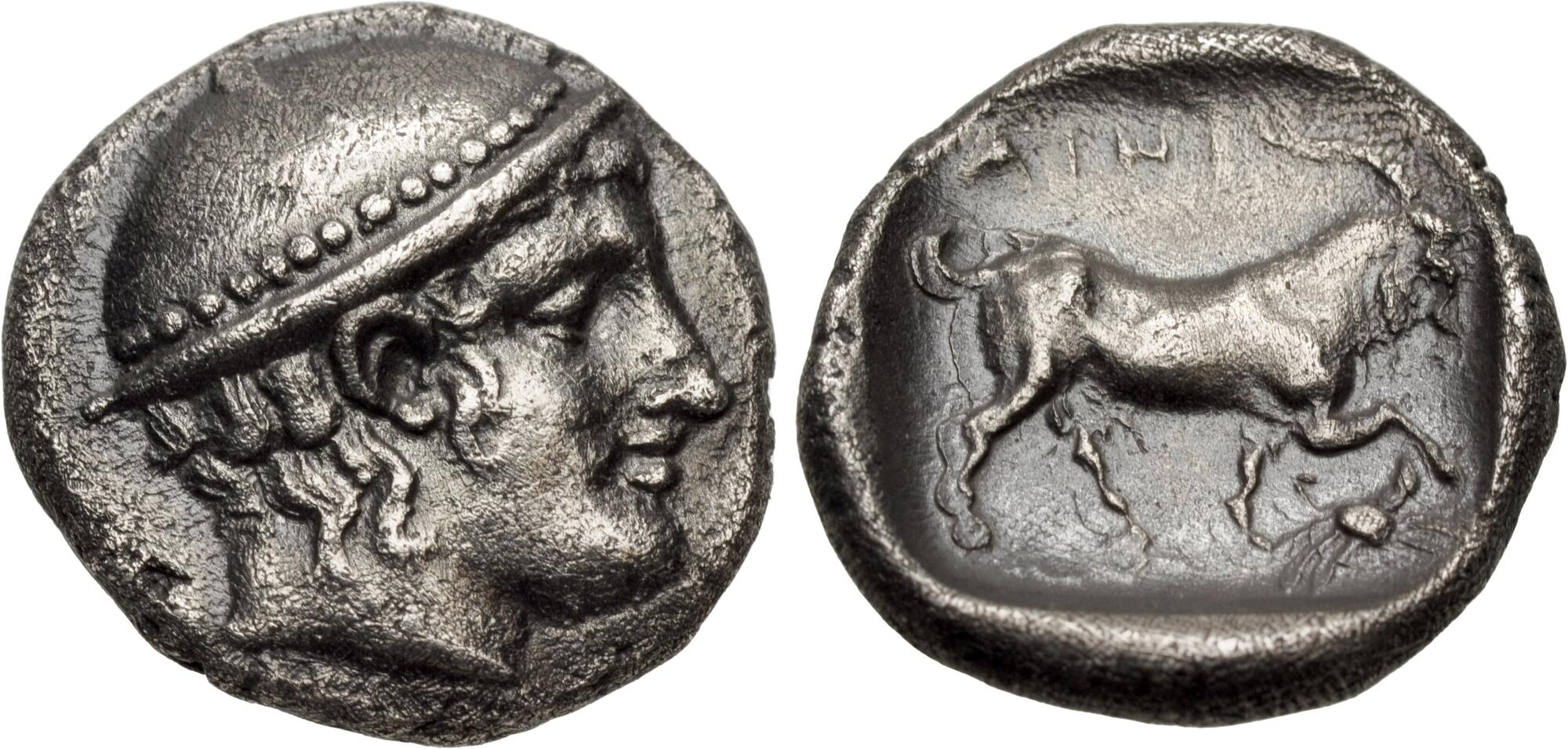AC 111 - Aenus, silver, tetrobols (431-407/6 BCE)
From SILVER
431 BCE - 406 BCE Silver 362 kg
Description
| ObverseInscription or printing placed on the obverse.: | Head of Hermes right wearing petasos. |
| ReverseInscription or printing placed on the reverse.: | AINI (Greek).Goat standing right, crab below raised foreleg, all within incuse square. May, |
Mint and issuing power
| MintIdentifies the place of manufacture or issue of a numismatic object.: | Aenus | Ancient regionAncient region.: | Thrace | Modern countryModern country: Greece | AuthorityIdentifies the issuing power. The authority can be "pretended" when the name or the portrait of X is on the coin but he/she was not the issuing power. It can also be "uncertain" when there is no mention of X on the coin but he/she was the issuing power according to the historical sources: |
Chronology
| FromIdentifies the initial date in a range assigned in a numismatic context. | 431 BCE | toIdentifies the final date in a range assigned in a numismatic context.. | 406 BCE | PeriodTime period of the numismatic object.: Classical 480-323 BC |
Physical description
| MetalThe physical material (usually metal) from which an object is made.: | Silver |
Median weightMedian of the weights of numismatic objects (in grams). in grams | 2.70 | DenominationTerm indicating the value of a numismatic object. Examples: tetradrachm, chalkous, denarius.: | tetrobol |
StandardStandard.: |
Image

AC111 Aenus.jpeg [1]
References
| Die study referencePublication of the study: | May 19501May 1950 | ||
| Coin series referenceReference to coin series study: | RQEMAC2RQEMAC, n° 111 | ||
Obverse dies distribution
| FrequencyFrequency of specimen in distribution. ᵖ | Number of obversesNumber of obverse dies. ᵖ (o) | % (o) | Number of coinsNumber of coins. (n) | % (n) | Die nameName(s) of the die(s). |
| 1 | 1 | 16.67 | 1 | 3.45 | 144 |
| 3 | 2 | 33.33 | 6 | 20.69 | 75, 181 |
| 4 | 2 | 33.33 | 8 | 27.59 | 179, 180 |
| 14 | 1 | 16.67 | 14 | 48.28 | 74 |
| Total | 6 of 6 | 100 | 29 of 29 | 100.01 |
Reverse dies distribution
no distribution is available
Quantification
| Number of obversesNumber of obverse dies. ᵖ (o) | 6 | Number of singletons (o1)The number of singleton coins. ᵖ | 1 |
| Number of reverse diesNumber of reverse dies. (r) | 13 | Number of coinsNumber of coins. (n) | 29 |
| Coins per obverse dieNumber of coins per obverse die. (n/o) | 4.83 | Coins per reverse dieNumber of coins per reverse die. (n/r) | 2.23 |
| Reverse per obverse ratioRatio of obverse dies divided by reverse dies. (r/o) | 2.17 | Percentage of singletons (o1)number of coins (n) divided by the number of singletons (o1) ᵖ | 16.67 % |
| Original number of dies (O) (Carter 1983 formula)The estimation of the number of coins according to Carter 1983 ᵖ | 6.71 | Coins struck if 20,000 as average productivity per dieCoins made if the average productivity for obverses (according to Carter) is 20,000. ᵖ | 134,200 |
| Original number of dies (O) (Esty 2011 formula)The estimation of the number of coins according to the singleton formula in Esty 2011 ᵖ (O) | 7.57 | Survival rate if 20,000 as average productivity per dieSurvival rate if average productivity is 20,000. ᵖ | 0.00022 |
| Coverage (o = % of O) (Esty 1984 formula)Esty 1984 - coverage (% of O) ᵖ (o = % of O) | 96.55% | Die productivity if survival rate 1/2,000Average productivity if survival rate is 1/2,000. ᵖ | 8,643.82 |
| Weight of silver (in kg) if 20,000 coins per die (O = Carter formula)Carter 1983 * Median weight * 20000 (*10 if gold or electrum) ᵖ | 362 kg <br /> 362 kg | Die productivity if survival rate 1/5,000Average productivity if survival rate is 1/5,000. ᵖ | 21,609.54 |
Remarks